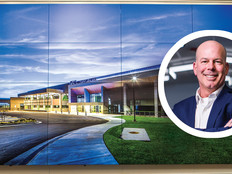One-to-One Computing
Pointers on measuring succss — from three programs that work.
EDUCATORS EVERYWHERE TALK ABOUT one-to-one computing: a notebook or tablet PC for every student and teacher. For many schools, one-to-one computing represents the ultimate in technology immersion, which leads to the high level of tech literacy schools want their students to achieve.
EdTech spoke to three schools: Brewster Academy, Nashwaaksis Middle School and The Urban School of San Francisco about their one-to-one programs and what difference their initiatives have made in improving learning. The goal is to look at why these schools implemented ubiquitous computing and discuss any measurable outcomes and how their programs fit with their educational philosophies.
The commonality among these schools is that they are student-centered and forward-thinking, dedicated to developing the individual student no matter where he or she is academically. The individuality of the notebook PC lends itself to that differentiation. But, before implementation, each school still had to create a rationale for its one-to-one program and provide for its sustainability. In all cases, committees were formed one to two years in advance, consisting of the technology personnel, teachers and administrators who would be driving the programs.
Costs are high and include not only hardware and software for notebooks, but also ongoing professional development and infrastructure upgrades, such as wireless networking, firewalls, additional servers, projectors and other classroom peripherals. These costs are not one-time capital purchases but are ongoing and must be maintained for the programs to thrive.
Another consideration is the personnel to maintain a large number of notebook PCs. As seen in large-scale rollouts in Maine, Texas and Virginia, a strong relationship with the hardware vendor is important. Many times, such large-scale contracts result in vendors stationing support personnel at schools and supplying loaners as part of the deal. All three schools agree that appropriate onsite technical support is a must as notebook downtime is a detriment to their programs. An appropriate number of loaners, anywhere from 6 percent to 10 percent, must be available to students at all times.
BREWSTER ACADEMY
Wolfeboro, N.H.
An elite boarding and day school, Brewster Academy began a schoolwide academic reform in 1993 that took into account everything from curriculum to policy statements and evaluation systems to one-to-one computing. Peter Hess, dean of studies, comments that the technology component of the reform is “the glue that holds and supports all other components of the design.” He believes schools must focus on teaching and learning, of which their notebook project was just a part. The goal of Brewster’s one-to-one program is to support and enhance the curriculum and provide a way to ensure that Brewster students have the technology skills they need in college and beyond.
Hess believes these goals have been met, based on a number of different findings. First, he points to SAT scores, college placement and retention rates, and discipline and character assessments. He is quick to point out, however, that it is hard to conclude that the notebooks alone were responsible for these positive outcomes, as they were all part of the school’s total reform effort. In addition, the school did conduct and publish a 1999 study looking at gender differences in computer competency and found that girls in one-to-one programs were more likely to be competent in technology skills than boys who were not in the program.
“All students can and must learn” is the credo of the leadership at Brewster. Hess, a 13-year veteran of the school and a former instructional support teacher, says that their intense faculty training model is the key to the success that their students achieve.
“The notebooks are one of the tools that get them there,” Hess says. “They are a natural extension of what we do, providing a support structure to our student-centered curriculum.”
Hess adds that the notebooks have become indispensable for students and faculty, citing the panic that overcomes both parties when notebooks malfunction. He also says, however, that notebooks alone are not enough. “It is quality instruction and implementation of research-based teaching practices with integrity that are most likely to improve student learning. The notebooks are simply the vehicles that can support the implementation of such practices.”
Nashwaaksis Middle School
Fredericton, New Brunswick, Canada
Originally chosen at random, students in two of the school’s seventh-grade classes were given notebooks in 2004 based not only on the initiative the neighboring state of Maine had taken, but also on the provincial government’s belief that investment in one-to-one access would have positive effects on students’ success in the global economy.
Teacher training was one of the biggest challenges the school faced. Jeff Whipple, a one-to-one technology mentor for School District 18, recalls that it was a challenge “to identify the best delivery model for teachers’ professional development without compromising day-to-day classroom management.” Whipple was formerly one of four original lead teachers in the notebook PC pilot for seventh- and eighth-graders at Nashwaaksis Middle School in Fredericton, where he team-taught 60 students.
Teachers’ comfort level with technology is critical as well, and “professional development options must be accessible and friendly,” says Whipple. The school ultimately chose a combination of pulling teachers from classrooms to work in small groups and working with them after school and on weekends. The solution is not perfect: Pulling teachers from class puts a strain on the classroom and school resources. The school is still looking for the ideal solution. For any school considering a one-to-one program, this crucial piece of planning must be discussed, budgeted and planned for to be ongoing throughout the year, every year.
The New Brunswick Education De-partment received funding from Microsoft and Hewlett-Packard to partner with two research teams to study the effects of one-to-one computing. The findings were based mainly upon surveys and interviews with students, parents, teachers and administrators at the six pilot schools.
As for benefits, Whipple points to the study showing that notebook use improves writing and research skills, especially among boys. Some students, who were originally resistant to the writing process, emerged as authors. The research also showed that some students became more efficient at locating information and were better able to manipulate that information as a result of utilizing computers as part of their studies.
Similar to Brewster Academy, Nash-waaksis has seen a trend toward more student-centered teaching, with students taking more responsibility for learning. There also has been a decrease in attendance and discipline issues for students in the program.
Based on the success of the Nashwaaksis program, the provincial government in New Brunswick committed an additional $10 million this fall to give notebook PCs to all seventh- and eighth-grade students and teachers at 27 of the province’s 110 middle schools. It is also exploring a complete rollout for grades seven through 12 across all public schools. In addition, the province’s 7,000 teachers received notebook computers in June. Equipping all students and teachers would require $50 million a year.
The Urban School of San Francisco

The Urban School’s Howard Levin says the one-to-one program has prompted students to produce sophisticated projects that encourage advanced thinking.
Photo Credit: ROBERT HOUSER
San Francisco, Calif.
A visitor to The Urban School of San Francisco will see ninth- through 12th-graders and faculty collaborating not only in faculty offices but in common areas, hallways and even in the basement, where Memphis, the campus dog, spends his days. Located in historic Haight-Ashbury, space is at a premium, requiring classrooms and offices to be shared, but also creating a close-knit, collaborative community of learners that has fully embraced its one-to-one program.
“Enhanced organization, communication, information access and student production are part of the rapidly growing lists of best practices that focus on learning advantages,” says Howard Levin, director of technology.
In addition, the school has seen a decrease in student disorganization and a dramatic increase in students being able to get curricular questions asked and answered in the five years since it launched the notebook PC program. Levin notes, however, that any formal measurement of the success of the notebook program is limited to survey data from students and the role the notebooks have played in their learning.
Levin observes that Urban students are producing more sophisticated school projects that lead to more advanced thinking, demonstrated by higher-order processing. One example of this is an oral history project, at www.tellingstories.org , begun in 2002 that continues to be updated each year.
Urban initially implemented its program without much buy-in or excitement from the teachers. They were concerned about distraction, loss of connection with the students, and an impact on the collaborative and openness of the school environment. Because classroom notebook use was never forced on the teachers and there were never any minimum requirements, faculty embraced them at their own pace. Often, students themselves help draw in reluctant faculty by requesting project alternatives that involve multimedia or some other electronic tool the teacher had not considered. Also, faculty offices are arranged so that teachers can collaborate with one another during their off periods rather than being confined to their own classrooms, allowing each department to self-discover uses that support their own programs.
Unique and Yet Not
One-to-one programs are as unique as the schools in which they are housed, but a common thread has emerged. These programs focus on individuality, take on a student-centered approach in the classroom and believe that one-to-one access is essential to learning. Issuing a notebook PC to every student and teacher, though, does not bring about educational change alone: There must be quality teachers and administrators to lead these changes.
ONE-TO-ONE QUESTIONS? Here’s Help
- www.laptopinstitute.com
The Laptop Institute’s 2007 conference will draw on independent and public schools from more than 40 different states and 10 countries to host sessions on one-to-one programs. - www.aalf.org
The Anytime Anywhere Learning Foundation, an advocate for one-to-one programs, hosts a one-to-one database and sends out a monthly newsletter. - www.irvingisd.net/one2one
The Irving Independent School District in Texas implemented a one-to-one program in 1996 and has built an extensive Web site of resources. - www.learningwithlaptops.com
Fred Bartels, director of IT at Rye Country Day School in New York, created the Learning with Laptops site as a information portal for schools with one-to-one programs.
ONLINE RESOURCES
How can you begin to gather information for a one-to-one program at your school? Try a questionnaire similar to the one created by the Episcopal Collegiate School in Little Rock, Ark. The author modified it to gather information for this article.
Stewart Crais is director of technology and media services at Lausanne Collegiate School in Memphis, Tenn. , and director of the annual Laptop Institute conference.






